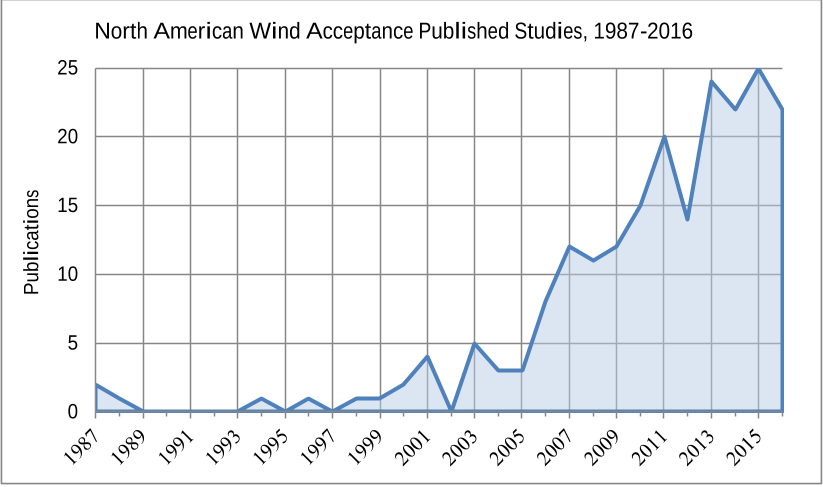
Lawrence Berkeley National Laboratory
Recent Work
Title
Thirty years of North American wind energy acceptance research: What have we learned?
Permalink
https://escholarship.org/uc/item/3747t3q4
Authors
Rand, J
Hoen, B
Publication Date
2017-07-01
DOI
10.1016/j.erss.2017.05.019
Peer reviewed
eScholarship.org Powered by the California Digital Library
University of California

Thirty years of North American wind energy
acceptance research: What have we learned?
Authors:
Joseph Rand, Ben Hoen
Energy Analysis and Environmental Impacts Division
Lawrence Berkeley National Laboratory
Electricity Markets and Policy Group
June 2017
This is a pre-print of an article accepted for publication in Energy Research and Social
Science. DOI: https://doi.org/10.1016/j.erss.2017.05.019
This work was supported by the Wind Energy Technologies Office within the Office of Energy Efficiency
and Renewable Energy of the U.S. Department of Energy, under Contract No. DE-AC02-05CH11231.

Disclaimer
This document was prepared as an account of work sponsored by the United States Government. While this
document is believed to contain correct information, neither the United States Government nor any agency
thereof, nor The Regents of the University of California, nor any of their employees, makes any warranty,
express or implied, or assumes any legal responsibility for the accuracy, completeness, or usefulness of any
information, apparatus, product, or process disclosed, or represents that its use would not infringe privately
owned rights. Reference herein to any specific commercial product, process, or service by its trade name,
trademark, manufacturer, or otherwise, does not necessarily constitute or imply its endorsement,
recommendation, or favoring by the United States Government or any agency thereof, or The Regents of the
University of California. The views and opinions of authors expressed herein do not necessarily state or
reflect those of the United States Government or any agency thereof, or The Regents of the University of
California.
Ernest Orlando Lawrence Berkeley National Laboratory is an equal opportunity employer.

Thirty years of North American wind energy acceptance research │i
Acknowledgements
This work was funded by the Wind Energy Technologies Office within the Office of Energy Efficiency and
Renewable Energy of the U.S. Department of Energy, under Contract No. DE-AC02-05CH11231. The
authors specifically thank Patrick Gilman, Jocelyn Brown-Saracino, and Jose Zayas from the DOE Wind
Energy Technologies Office for supporting this research
The authors would also like to thank Jeremy Firestone (University of Delaware), Ryan Wiser (Lawrence
Berkeley National Laboratory), Eric Lantz (National Renewable Energy Laboratory), Gundula Hübner
(Martin Luther University), and Jarett Zuboy for their contributions and suggestions to improve this
review.

Thirty years of North American wind energy acceptance research │ii
Table of Contents
Acknowledgements .................................................................................................................................................................. i
Table of Contents ..................................................................................................................................................................... ii
Abstract ...................................................................................................................................................................................... iii
1. Introduction ....................................................................................................................................................................... 1
1.1 Background and Motivation ........................................................................................................................... 1
1.2 Justification for North American Focus ..................................................................................................... 2
2. Method of Literature Review ...................................................................................................................................... 3
2.1 Selection of Publications to Review ............................................................................................................ 3
2.2 Data Collection, Coding, and Qualitative Analysis of Papers ............................................................ 5
3. A Brief History of North American Wind Energy Acceptance Research ................................................... 5
4. Limitations of Previous North American Wind Acceptance Research ...................................................... 7
5. Overarching Aspects and Explanatory Variables in North American Literature ................................ 10
5.1 Socioeconomic Aspects .................................................................................................................................. 10
5.2 Sound Annoyance and Health Risk Perceptions .................................................................................. 12
5.3 Visual/Landscape Aspects, Annoyance, and Place Attachment .................................................... 13
5.4 Environmental Concerns and Attitudes .................................................................................................. 15
5.5 Perceptions of Planning Process, Fairness, and Trust ...................................................................... 16
5.6 Distance from Turbines (Proximity Hypothesis) ................................................................................ 18
5.7 Other Proposed Correlates of Acceptance ............................................................................................. 18
6. Lessons learned in 30 years of wind acceptance studies .............................................................................. 19
7. Knowledge gaps after 30 years: Areas for future research .......................................................................... 21
8. Conclusion ........................................................................................................................................................................ 22
References ................................................................................................................................................................................ 22
Appendix A ............................................................................................................................................................................... 30
Table 1: Explanatory variables in N.A. wind acceptance literature & research suggestions ......... 30
Table 2: Research approaches and methods in North American wind acceptance literature ...... 33
